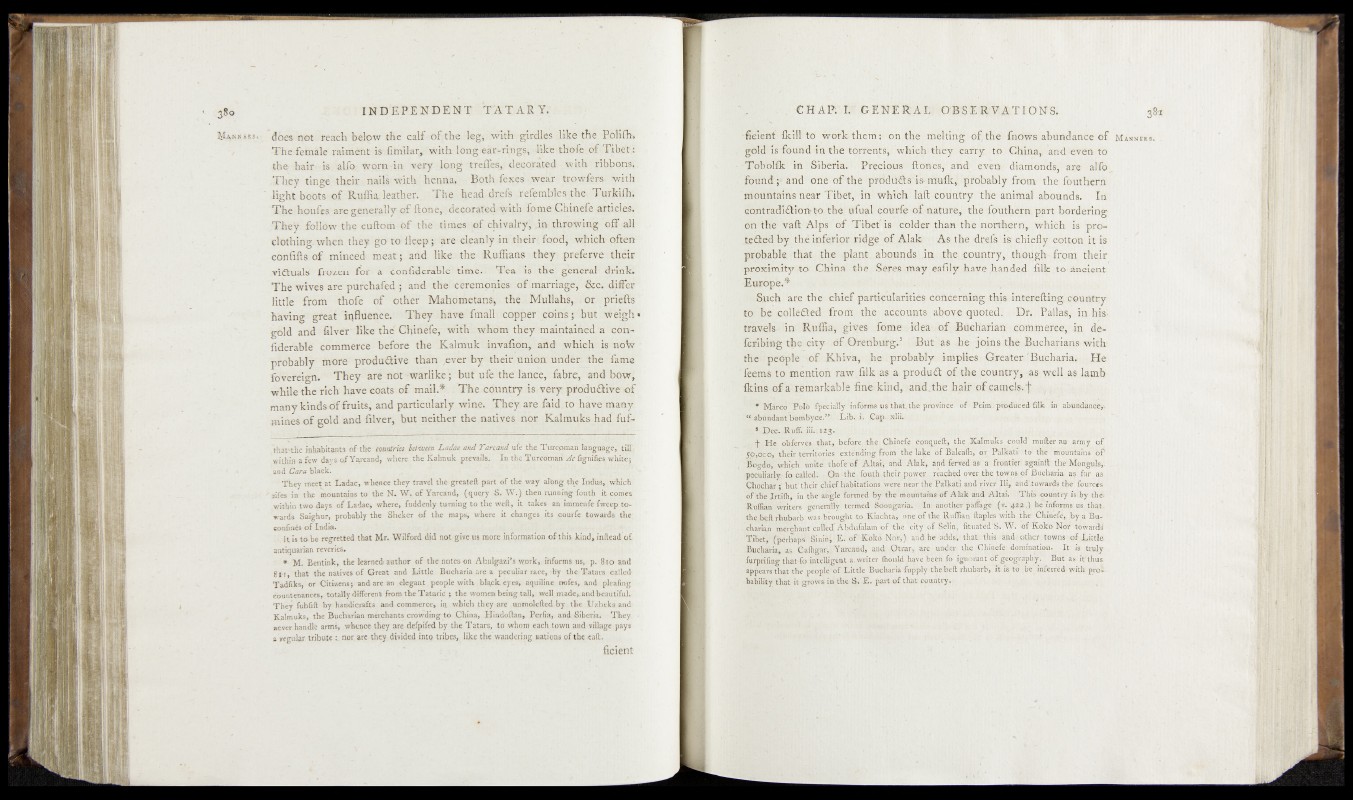
ISÆakkersx- does.not reach below the calf of .the leg-,, with girdles like the Polifh-j
The female raiment is fimilar, with longieàr-ringl^.Jike thofe of Tiia'Hf:
the hair- is alfo- worn in very long Tifèfies, decorated with ribbons;
They tinge' their nails with henna, . Both .feses'...wear trowfers- with
' light boots of Ruflia. leather. The head dre-fs refembles the Turkiffi.
The houfes are generally óf Hone, ; decorated with Tome Chinefe articles.
They follow the cuftoin h f the times of chivalry; in throwing off all
clothing, when. they go- to Heep; are cleanly in f heir food, which often
con lifts of minced- meat; and like the Ruffians they preferye tthëip
victuals' frözéh fôr a confidërahle ' time.. * Tea is the* general drinkl
The wives are purchafed ; and thebceremonias oflmarriage, &c. differ
little from thofe of other Mahometans, the Mullahs,, .or priefts
hkving great 'influence,' They have fmall copper coins ; but -v^elgh
gold and filverTike the" Chinéfe; with: whom they maintained a con«
fiderable commerce before the Kalmuk invafion, and which is nota
probably more produâive than ,ever by their union uhderttfip-'fame
fovereign. They are not warlike ; but ufe the lance, fabre, a>nd bow*
while the rich have coats of mail.* The country is very productive o f
many kinds of fruits, and particularly wine. They are faid.to have many
mines of gold and hiver, hut neither the natives nor Kalmuks had fuff
.'that'the inhabitants of the countries Between Lada* and Tarcand ufe the Turcoman language, tilt
within a few days ofYareand, where the Kalmuk prevails. In the Turcoman Ac lignifies white;
. TinÀ Cara black.
- They meet at Ladac, whence they travel the greateft part of the way albrig the Indus,, which-1
>nfes- in the mountains to the N, W. of Yarcand, (query S. W.) then running fouth it cornea
within two days of Ladac, where, fuddenly turning to the weft, it takes an immenfe fweep towards
Saighur, probably the Slicker of the maps, where it changes its çourfe towards the*
confines of India.
It.is. to.beregretted that Mr. Wilford did not give us,more information o£ this, kind, inftead,of,
antiquarian reveries.
*■ M. Bentink, the learned' author of* the notes on Abulgazi’s work,, informs us, p. 8 to and
g ,., that- the natives of Great apd 'Little Bucharia are a peculiar race, -b'y the-Tatars called-
Tadfiks, or Citizens ; and are an elegant people with blqck. eyes, aquiline, nofes, and pleafing
countenances, totally different from the Tatarie ; the women being tall,, well made,.and beautiful..
They fubfift by- handicrafts and-commerce, in, which they are unmolcfted.by. the. Uzbeks and.
Kalmuks, the* Buchanan merchants crowding to China, Hindoftan, Perfia,. and .Siberia. They
■ever handle arms, whence- they are defpifed by the Tatars, td whom each town and village pays
a regular tribute t. nor. are they divided into tribes, like the wandering nations of the. ealt.
ficient
'fieienf {kill to1 work» them's* on .the* meUitt^-:-ofj.the'fno'ws abundance of Manners, .
goldf faHbund in the torterfts; ’ whleijithby* fc'arry flb' Chinav and'even to
-Tobolfk ’in Siberia. Precious even' diamond«, are alfo,
found';* and *one o#the;prodii^ts‘is- mufkj'pt'obably'-from the fouthern
'mountains near Tibet, in Whfl&t' lifi^tftsjatry«Ihe* animal abounds. In
contradidtiorn to. the ufupU.eputffe *of mature^ E^|fouthern phrt bordering
©n the vaft Alps of Tibet is- holdei?'ChaHfth4 'hbEthern» which is protected
by the inferior ridge of Alakv g As-' the dreC^iis: chiefly cotton iris
probable, -that the -plant ^bounds in the.poupTy, thopgh .from, their |
proximity-ho ,China.-bhe. Sepes-may eafily have handed Tflk tp Ancient
Europe.* * | |j " ' * „ . .. ■
S.uch are the - chief particularities1 coitaerning this 'imMjfefti.ng;
to bexpiIefl:ed^r©m.--^hpj(M^dip^a^©?!5e quoted1,';>^||ra%|la's^' in hi«,
travels in Ruffian, gives fome idea • of BuGharian commepee; in defer
i bin g the city of Orenburg.5 But as he joins the Bpeharians With'
the‘'people p f Khiva//-he-- probably implies Q-reater 'Bpeharia« < Jle
Teems to mention raw filk-as a product of the country; as we|ij^sv,Iamh
Iki-ns of a remarkable fine kiad^arfd^the hair ^pF-parn-el.s,;^ , v
Marco Polo fpecially.informs ns'that, the'province of' Peim ..produced fills in abundance,■-
“ abundant bomByce.” ' - Lib. i; ,t .qlv d.ui
^ ^il&'ec...Ruff. «1.123,
4- He obfer'yes that, before,.^he . Chinefe conqueft, the .Kalmuks could mutter an army of
50,ocOjIThlir ..territories extending from1 the lake of Balcafli, qr .Palkati to the j m'oun.t’mhs’ o f
Bogdo,' which unite tliofemf Altai; and Alak, and ferved as a frontier- againft the Monguls,. .
peculiarly fo called: Qn -the fouth. their power cached over, the towns. opBuGhairia as far as /
Chochar; but' their chief habitations were near the Palkati and river Hi, and .towards the*, fo’urces
of'the Jrtilh, in the angle formed, by the mountains of Alak and Altai. This country is by the.-
Ruffian writers generally termed Sooiigaria. ‘Irij another paffage (v. 422.) he informs us that,
the belt rhubarb was brought to Kiachta, one of the Ruffian llaples with the Chinefe, ,by a Bu-
charian merchant calleff Abdufalam of the city; of Selin, fituated S. W. of KokoNor -towards
Tibet,' (perhaps ‘SmiT E. of Koko Nor',) and. he. adds; that this-and-other towns of Little.
Bucharia, as Caffigar;Yarcand, and Otrar, are undei the 'Clhinefe; domination. It is truly
furprifing that-fo intelligent a. writer (hould, have been fo ignorant o f gtqgraphy.. But as it'thus,
appears that the peoplk'pf Little Bucharia fupply the heft rhubarb, it is to -be:inferred with pro?
Lability that it grows in the S. E. part of that country ... I